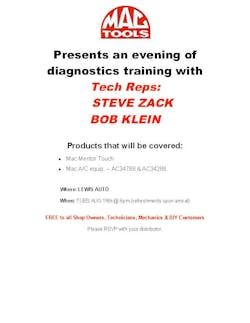It’s “back to school” time! Not just for students, but for your customers, too.
Some dealers believe technical products, like scanners and scopes, are best sold with technical training. They’re proponents of “Tool Schools” lead by professional trainers who know their products inside-out.
I like the energy of face-to-face contact. But some industry leaders have different ideas on how to present technical information in the Internet age.
Read on to decide what may be the best method for you...
Q: Don’t my customers know everything they should about the scan tool they use every day?
A: You’d think so. But I don’t know everything about the tools I use everyday. I’m always learning some new trick on my MacBook or web browser. And my decade-old universal TV remote does one thing: turn on my TV -- not very universal. Perhaps you can identify.
The same is true for your customer. They may use a tool every day, but don’t use or realize all the features on their scanner or scope. However, good product training also shows the technician what his current tool doesn’t do. Creating a bit of “tool envy” helps sell tools.
Scan tools are evolving at lightspeed. MPC Publishing co-owner and trainer Bill Peek says that top drivability guys are replacing scan tools in as little as six years. That can make for a big learning curve and is one reason product demos tend to be very popular among driveability techs.
The most successful trainers are those doing actual training and not a sales pitch, says Mac Tool District Manager Jim Holtz of West Valley, N.Y., who has had a lot of success with product training events in his district.
Q: Isn’t putting together an event a lot of work?
A: The first one can be a lot of work. But once you have a system, it gets easier, says Holtz.
One key is to not sweat the small stuff.
Originally Holtz worked hard on trying to get his dealers to agree on a date. Then he realized that he was wasting a lot of time and he never got a consensus. So, he decided to just choose a date and let the chips fall where they may. He hasn’t sweated that detail again since.
Holtz usually alternates locations from one end of his territory to the other. He finds the furthest the average tech will travel for a training event has been about 45 minutes. So promote your event in about an hour radius of your venue to allow for the rare exception.
Q: Where should I hold the event? How much should I expect it to cost?
A: Holtz says he has also been fortunate to find good locations for his events.
Often he gets free use of a community college automotive classroom and bay. The instructor is usually very happy to open up his facilities and sit in on the training. The classroom/bay set-up provides the perfect learning environment.
If he can’t get a college classroom, he’ll ask a larger customer to use his shop. They usually have a pizza party in the waiting room and use the bay area for training. The upside of this arrangement is he gets nearly all the technicians from that shop to attend this event.
Holtz says the event costs him about $100 for pizzas and drinks. He finds it’s well worth it when he adds up the sales generated by a training event.
So, if your DM is doing all this hard work, all you need to do is invite your customers. That seems easy.
Q: What can I do to get as many techs as I can to come to the event?
A: “If you feed them, they will come.”
Just kidding. I wish it was that easy. Although food is a must-have at an after-work event it’s not the main draw. If you want your customers to carve time out of their busy lives for your event, you need to promise valuable, relevant information. Focus on driveability guys for scan tool and diagnostic demos. And try to make the event both educational and fun.
How do you make technical training fun? Take a page from Tupperware. Don’t think of it as product demos, think of it as a party. It’s a chance for techs to meet other techs and relax. Keep the event loose but keep things moving.
Try holding a drawing to add to the party vibe. If it’s a district event, ask the flag to ante up a few prizes like gift cards or logoed apparel. Mention “door prizes” on your invite flyer, but don’t expect that to be the major draw anymore than food is.
Speaking of invitations be sure to invite everyone on your route. Hand out invites to the appropriate customers and encourage them to bring a co-worker. Post the flyer on your truck bulletin board. Look into Facebook’s invitation tool. Be sure you cover all the important information -- including addresses and phone numbers. Ask someone to double check for you. It can be easy to overlook details. (I forgot the church address on my wedding invite 17 years ago. It’s a wonder anyone showed up!)
Start promoting early and keep reminding everyone -- even after they’ve registered. (And be sure they RSVP so you know how many to plan for on the food and seating.)
Let your excitement about the event be contagious. If your event is fun and informative (not one long infomercial), the word will get around and next time more customers and prospects may come.
Q: My DM doesn’t hold after-hours product training. I think he’s lazy. What do you suggest?
A: Lazy? Not likely. There are any numbers of reasons a district manager may not do product training events. The most obvious is that historical sales don’t support a manufacturer sending out a trainer. You can’t have a training event without a trainer.
But that doesn’t have to stop you from finding creative ways to hold your own event.
Foremost, don’t go it alone, find other nearby dealers in your flag to join you. That means less work for each person and more potential attendance.
The biggest part is getting a trainer. Ask your DM for help. If a trainer can’t come to you, ask if you can bring your audience to him using a webinar service or Skype. (Skype-to-Skype video calls are free. You may also want a projector.) Do a quick trial run to work out any bugs.
Think about getting the presenter’s permission to record and post the session to YouTube customers who couldn’t make it. Uncomfortable with technology? Ask a tech-savvy young person who could use the pizza money.
Can’t get a manufacturer trainer? Try a local trainer or teacher. Or, better yet, several trainers/teachers, each doing a short demo. Tell them you can pay, but offer them a small amount or a truck gift card as a thank-you for helping. Who knows? You could end up with a new customer!
Q: Should I take orders at the event?
A: Holtz says most of his dealers don’t take orders at his events. But that doesn’t mean you can’t. I think you can close more deals if you promote a limited-time special pricing or promotional package designed especially as an event tie-in.
Obviously, have brochures or printouts on every product you demonstrate. Include the information on your specials and make the end date of any specials big and bold.
Just remember the key to success is in the follow-up. Ask for the order several times over the next several weeks. And if you’ve created a special on the product remind them that the discount deadline is looming.
Q: What if product training doesn’t work for me?
A: If you don’t find live training events productive, don’t give up. There are other ways to teach your customer a diagnostic tool, like lending them a demo unit.
“Whenever possible, pick up a scan tool at a discount and put it in your customer’s hands to touch and play with,” Don Russell tells dealers. Russell, diagnostics product manager with Cornwell Quality Tools say Cornwell district managers don’t hold many product training events. Instead, they encourage their dealers to create a tool loan program and rotate a demo scan tool among their driveability customers.
By letting your customer “play before they pay,” you’re giving them a week-long self-training program. If they have a fully functional diagnostic tool and the tech support hotline, they can discover all the features of the tool that are the most relevant to them.
“It’s important to keep the loan to only one week,” says Russell. “No matter what happens you need to take the tool back on your next visit. Tell him someone else is waiting for the tool.” If necessary, offer your customer the tool again in a few weeks.
By keeping the loan period to a week, you’re giving him a deadline and creating a sense of urgency. If he is really interested in the unit, he’ll do everything in his power to use it as much as possible over the next seven days. If he likes it, he’ll buy one. If not, it’s on to the next customer.
Think of it as a test drive. You could talk about a Bugatti or you could test drive one. If you have the money to buy one, there’s nothing more powerful than putting your hands on the wheel to close that sale.
Q: How can I be sure I’m recommending the right diagnostic tool for my customer?
A: You’re asking the wrong question! Remember we’re talking about educating customers. You should be asking: How can I give my customer the information he needs to pick the right scan tool on his own. You shouldn’t be picking, he should.
Educating your customer gives him the resources to make an informed decision. (And if he makes his own decision, he can’t blame you if he doesn’t like his choice!) But in the Internet age, educating doesn’t just happen in a classroom or training video.
Cornwell has a free online “Scanner Planner” to inform their dealers and customers on scan tool features (http://cornwelltools.com/scantools/planner2.php). By clicking any of about 100 check boxes, a Cornwell customer can choose the scanner with the exact features he wants or determine all the features on a scanner he’s considering. The planner will even tell a customer if his dream scanner doesn’t exist yet (like a Marine scan tool).
“I built the Scanner Planner after realizing I was getting asked the same questions over and over,” says Russell. So he gathered some of the most common feature questions and put the answers at his dealer’s and customer’s fingertips.
About the Author

Phil Sasso
Phil Sasso is president of Sasso Marketing Inc. (www.sassomarketing.com), a technical marketing agency providing advertising, public relations and promotional services to tool and equipment marketers. Subscribe to his free marketing tip at philsasso.com/blog.
